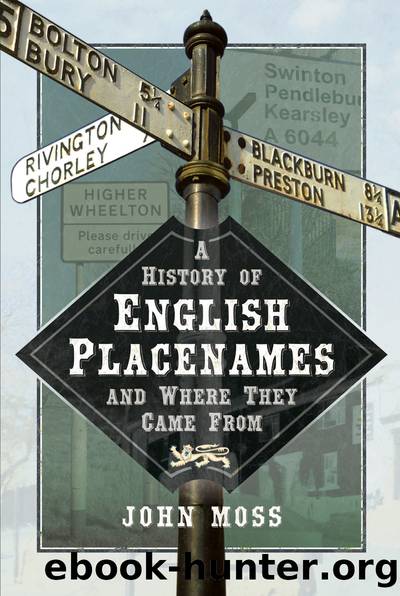A History of English Place Names and Where They Came From by John Moss

Author:John Moss
Language: eng
Format: epub
Tags: History / General
Publisher: Pen & Sword Books
Published: 2020-05-05T00:00:00+00:00
Part Ten
The Home Counties
Bedfordshire, Berkshire, Buckinghamshire, Hertfordshire, and Oxfordshire
A map depicting the Home Counties of England.
Abingdon
The name is probably derived from a person called Abba, Aebba or Aebbe, who was one of its earliest settlers, with the addition of two Old English suffixes: âingaâ, signifying the people, tribe or family, and âdunâ, a hill. The placename may therefore be taken to mean âthe hill of Aebbaâs tribe or peopleâ. Aebba was possibly the saint after whom St Ebbeâs Church in Oxford was dedicated. Abingdon is actually located in a valley, not on a hill, prompting speculation that the township was moved when Abingdon Abbey was founded around 676. Reputedly, this was the first monastery to be established in Britain, though some argue that Glastonbury holds that distinction. King Edgar (âthe Peaceableâ), was educated at the abbey. In 989, a Saxon Parliament assembled at Abingdon, at which time it was known as Abbandune. Domesday spelt the placename as Bertune, locating it historically in the County of Berkshire, in the Homer Hundred, held by the abbey in 1086, and assessed before the Conquest at sixty hides â afterwards at just forty hides.
Aldermaston
The origin of this West Berkshire placename is derived from the Old English âearldormannâ (equivalent to a modern alderman), with the suffix âtunâ added. Hence, âthe aldermanâs estate or settlementâ. It was recorded in the Great Survey of 1086 as âthe kingâs land of Aeldremanestone in the Theale Hundredâ, parts of which were held for him by various knights and nobles, including the Count of Evreux, Hugh Bolbec, Roger de Lacy, Robert dâOilly, Bishop Osmund of Salisbury, Ralph Piercehedge, and many others, including several Saxon tenants.
Amersham
The placename is based on a man called Ealhmund, an early settler of the land, and the Old English suffix âhamâ, signifying a homestead or settlement. Hence, the placename means âhomestead of Ealhmundâ. It was recorded as Agmodesham in the County of Buckinghamshire in 1068 and held by Geoffrey de Mandeville for his master, Lord Bertram de Verdun, who was abroad on the kingâs service.
Amptill
The name of the Bedfordshire township of Amptill dates from Saxon times, when it was called Aemethyll, derived from the Old English word âaenetteâ, meaning âantâ, and âhyllâ, a hill. Hence, the name means âanthillâ, or âant infested hillâ. The Domesday Book refers to it as Ammetelle, in the Redbornstoke Hundred, held by Nigel de la Vast for Nigel dâAubigny. Before the Conquest, the manor had belonged to âAlweard, a man of Aelfric, son of Godingâ, and was valued at four pounds.
Aspley Guise
The Old English word âaespeâ referred to the aspen tree, and the affix âleahâ meant âwoodland clearingâ. In the mid-tenth century the placename was recorded as Aesplea. Hence, Aspley means âwoodland clearing where aspen trees growâ. The village entry in Domesday recorded it as Aspeleia, and listed it as quite a large estate supporting twenty-five households in the Manshead Hundred of Bedfordshire, held in 1086 by Hugh de Beauchamp, having been the property of Leofeva before the Norman Conquest. The
Download
This site does not store any files on its server. We only index and link to content provided by other sites. Please contact the content providers to delete copyright contents if any and email us, we'll remove relevant links or contents immediately.
| Africa | Americas |
| Arctic & Antarctica | Asia |
| Australia & Oceania | Europe |
| Middle East | Russia |
| United States | World |
| Ancient Civilizations | Military |
| Historical Study & Educational Resources |
Machine Learning at Scale with H2O by Gregory Keys | David Whiting(4094)
Never by Ken Follett(3758)
Fairy Tale by Stephen King(3192)
The Man Who Died Twice by Richard Osman(2977)
Oathbringer (The Stormlight Archive, Book 3) by Brandon Sanderson(2833)
Will by Will Smith(2766)
Rationality by Steven Pinker(2271)
The Dark Hours by Michael Connelly(2210)
Can't Hurt Me: Master Your Mind and Defy the Odds - Clean Edition by David Goggins(2141)
The Dawn of Everything: A New History of Humanity by David Graeber & David Wengrow(2103)
Friends, Lovers, and the Big Terrible Thing by Matthew Perry(2097)
Principles for Dealing With the Changing World Order: Why Nations Succeed and Fail by Ray Dalio(1951)
HBR's 10 Must Reads 2022 by Harvard Business Review(1761)
A Short History of War by Jeremy Black(1742)
Go Tell the Bees That I Am Gone by Diana Gabaldon(1668)
515945210 by Unknown(1582)
A Game of Thrones (The Illustrated Edition) by George R. R. Martin(1562)
Kingdom of Ash by Maas Sarah J(1494)
443319537 by Unknown(1450)
